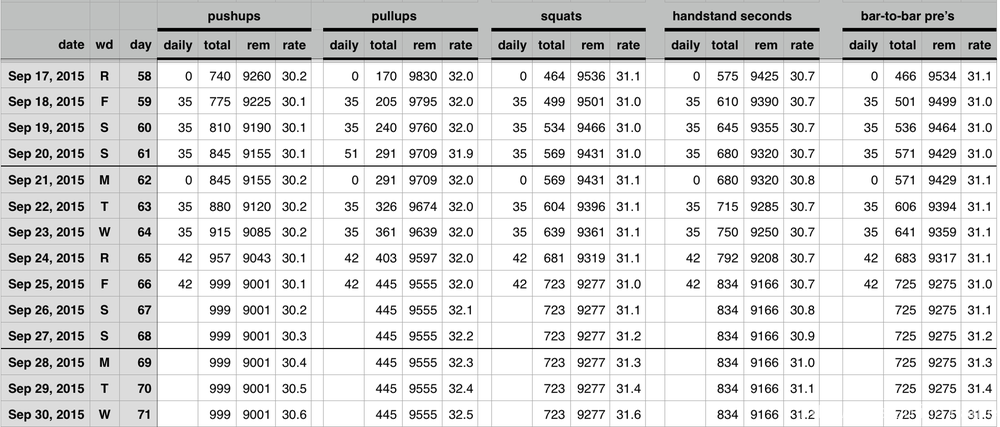On Saturday, Nov 7 I rolled past 1,000 pull-ups! …but I’m actually falling behind on the overall pace needed to reach my 10k goal. It’s time to find some renewed motivation.
A few months ago, I was working with a friend on a planned exercise program. He had me planning workouts targeting specific times in heart rate zones, running and other activities. After about a year, we felt we no longer needed to check in regularly, and we went our separate ways. (No bad blood, just moving along our separate orbits.)
That was a mistake. It turns out that I didn’t realize how critical the accountability aspect of working with him was. So training on my own, I slowly drifted from “diligent”, to “sporadic”, to “uh oh…”.
A few aspects of my physical activities started slipping; most notably my progress on my 10k project. For a few weeks after I realized this was happening, I tried to re-energize myself. But it just wasn’t happening.
I’m a big believer in explicit goals and tracking progress. But motivation is the key. I have to find something that motivates me – a project, goal, challenge, location, anything – and run with that until it loses it’s luster. Then I find something new to motivate me. So while the goals and tracking are long(-ish) term, the motivation can be anything that works in the short term.
I recently reached out to another friend about working together as “accountability” partners. We started by meeting for lunch. He’s not a Parkour guy (neither was Mike who I was working with before), he’s a martial artist and is knowledgable about weight lifting. As a bonus, he’s recently been on a “body weight exercises” bender, which makes a lot of what we’re doing for training pretty similar. We had a long, animated lunch discussing everything from exercise specifics, to Parkour, to weight lifting. I left lunch highly motivated and with a pile of new ideas.
So three new things…
1. I’ll be starting each week by communicating my plan to my partner. This requires me to actually sit down and make a plan.
2. On each day that I have a planned workout/activity/whatever, I check in with a brief post-activity status report. This adds a bit of cost/guilt to get me going. We also discussed that this could be later expanded to have some sort of actual cost for failure — a physical penalty, or even a cash fine. (We’re reciprocal accountability partners so he’s also checking in with me on his plans.) But for now we’re going with simply communicating.
3. I’m starting a 12-day, designed pull-ups program. In my 10k project, pull-ups are the weakest activity, so I particularly need to build up strength here before I can go on piling on numbers to reach the goal.
ɕ



